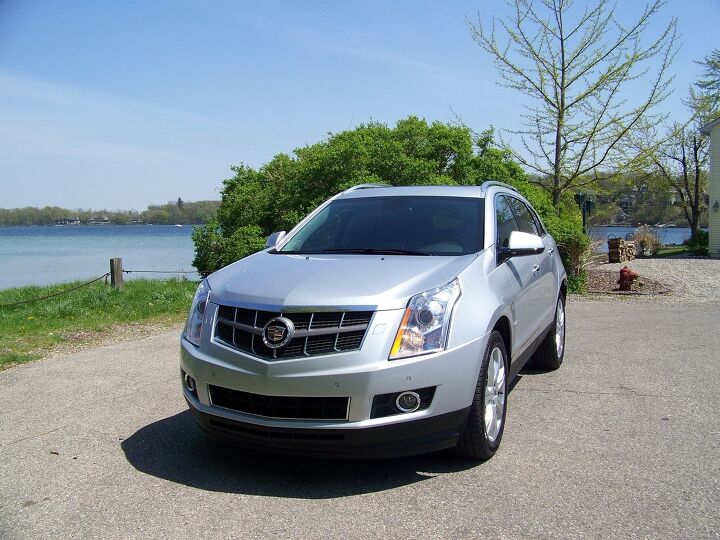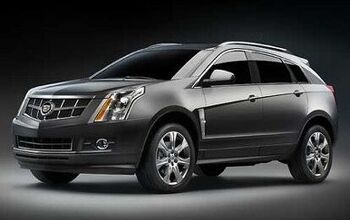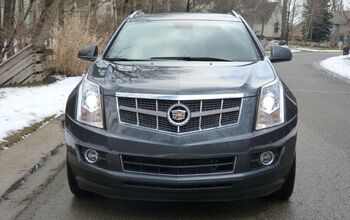Review: 2010 Cadillac SRX
Figuratively as well as literally, Bob Lutz’s work at GM is now done. Shortly before the towers fell (it seems so long ago) Rick Wagoner answered many an auto journalist’s prayers by recruiting the living legend to dramatically improve the company’s product development process and the cars it yields. In retiring (not for the first time, but probably for the last time), Lutz has declared this mission accomplished, with GM’s latest cars as proof. The Cadillac SRX 2.8 turbo is the most expensive—and so least cost-constrained—of these new cars. What does it tell us about what Lutz was able to accomplish, and about what work remains?
Historically, the “car guys” within the auto makers have been engineers. And yet Lutz, often proclaimed the ultimate “car guy,” started out in sales and marketing. No matter. Upon arriving at GM, he reduced the power of both marketing and engineering in favor of design. Marketers with questionable taste would no longer interfere. Engineers would no longer decide what could and could not be done. Designers would once again be free to execute their visions. So,
if nothing else, the new SRX should look a lot better than the old one.
Not that this was a high bar to clear. Constraints imposed by borrowing heavily from the CTS sedan weren’t the only challenges faces by the designers of the original SRX. It was conceived in cluelessness, with even the vehicle’s basic proportions subject to much doubt. Lexus with its pioneering RX had opted for the chunkiness of an SUV. Should Cadillac do the same, or make the most of a rear-wheel-drive chassis with a longer, lower, more wagon-like shape? Ultimately they opted for the road less traveled—a route even the purveyor of ultimate driving machines dared not take—and paid the price. The original Cadillac SRX won buff book comparison tests. But it did not win the comparison tests that really mattered, and was greatly outsold by the Lexus.
Cadillac didn’t repeat this mistake (yet). For the second-generation SRX it has essentially taken the Lexus RX—chunky proportions, front-wheel-drive platform—and styled it like a Cadillac. Copy cat, cop out, or simply the right way to go? Perhaps all three—they’re not mutually exclusive.
With the new SRX, Cadillac has successfully transferred its Stealth fighter-influenced “art
and science” aesthetic to the proportions people clearly prefer in a crossover. This is post-Lutz art and science, so the original’s severe forms have been softened to add some conventional beauty to the mix, but it’s still bolder than the competition and distinctively Cadillac. Look closely at the tail lights for a tasteful homage to the tasteless fins of Cadillac’s glory days. A caveat: wheels make a huge difference. Eighteens, the standard size, never looked so small. This exterior demands the optional 20s. Because of its proportions and those large wheels, the SRX looks like a compact crossover. But don’t let your eyes fool you—with an overall length of 190.3 inches, it’s even a few inches longer than the clearly midsize Lexus RX and Lincoln MKX, and about eight inches longer than the Audi Q5 and Volvo XC60.
You can save a bundle by opting for the roomier Chevrolet Equinox or GMC Terrain. But the extra cash for the Cadillac doesn’t only buy a more prestigious badge. The SRX is a half-sib to the mainstream crossovers, sharing some platform bits but not others. It does share a premium platform with the upcoming Saab 9-4X, and even the sound when closing the doors suggests that the Cadillac is a different class of vehicle.
Lutz wasn’t always a champion of interior quality. Under his watch Chrysler cranked out some of the industry’s chintziest cabins. But he saw the light between gigs, and Cadillac benefited most of all. With an upholstered IP, real wood trim, aromatic leather, and snazzy red, white, and blue instrument cluster, the new SRX is far nicer inside than the Equinox and Terrain. As it ought to be. This said, some of the knobs would benefit from a more premium surface and feel. Beyond materials, this is
an attractively styled interior, with numerous artfully interesting details.
If only as much thought had gone into the driving position and seats as appears to have gone into the instrument cluster. As in other recent GM designs, the pillars are massive, the base of the windshield is in another timezone, and the beltline is relatively high. Consequences of giving the designers free rein? The beltline and raked windshield, most likely. But surely the A-pillars aren’t monstrous for aesthetic reasons. Or simply for safety reasons—those in the Volvo XC60 are much thinner. So why are they so thick? Bean counters deny requests for the highest strength steel? The engineers would have preferred thinner pillars, so something got in their way and was allowed to stay in their way. Thin pillars must not be a Lutz priority.
Positioning the IP and windshield so far away does enhance perceived roominess. But it also makes the SRX feel larger and less agile, an attribute which, Lutz or no Lutz, continues to typify GM vehicles. Add in the high rising beltline and thick pillars, and visibility from the driver’s seat—a key reason people buy this class of vehicle—isn’t up to the class norm. For backing up you’ll want the optional rearview monitor. An around-view monitor like that offered in Infiniti’s crossovers would provide a more complete picture of what’s going on outside the bunker.
Like those in the CTS, the SRX’s front seats don’t quite feel like luxury car seats. They’re too small and too firm for a luxury vehicle role, yet the bolsters are too widely spaced for a more sporting
role. A deal killer for some physiques: the rock hard headrests jut far forward in the interest of whiplash protection. Competitors somehow avoid taking such extreme measures.
Rear seat passengers can get more amenities here than in an Equinox or Terrain, including climate controlled rear air vents and seat heaters. What they don’t get: as much rear legroom as in the Theta twins. And yet there’s still considerably more than most direct competitors offer. Unfortunately, the spec sheet isn’t everything. Many competitors have more comfortably positioned and shaped rear seats. Children also have an easier time seeing out of other crossovers; younger ones will find their view limited to treetops in the SRX. Then again, in an SRX with the optional dual screen video system they won’t be looking out the windows anyway. Cargo volume is competitive. A U-shaped rail for securing cargo looks nifty, but what’s the functional benefit?
The SRX’s standard 3.0-liter V6 kicks out 265 horsepower—at 6,950 RPM. The torque peak, where a much less impressive 223 foot-pounds reside, is a similarly lofty 5,100 RPM. Similar figures amazed the world two decades ago in the Acura NSX. And GM’s new 3.0 might have dazzled in a reworked Kappa sports car. But in a 4,200-pound SUV (4,400 with AWD) it’s out of its element. One gets the impression that GM had a much lower curb weight target for the new SRX (and a number of other recent vehicles), and then missed it by a few hundred pounds—not the sign of a well-functioning product development system. For the 2011 model year, GM has seen the light and yanked this engine from the similarly hefty Buick LaCrosse AWD in favor of the much stronger yet equally efficient 3.6. But the 3.0 soldiers on in the SRX, perhaps because a 3.6 would step on the
toes of the optional 2.8-liter turbo.
The 295-horsepower 2.8-liter turbocharged V6 accords itself fairly well in the SRX. Because of the mass it must propel this engine never feels especially strong, but unlike the 3.0 it never feels sluggish or strained, either. Only those paying very close attention will be aware that the engine is boosted. Throttle response isn’t as sharp as it is in the best naturally aspirated engines, and there’s some surging and lulling under light throttle, but boost lag isn’t readily evident. Neither is torque steer—the boosted engine is only available with all-wheel-drive. Fuel economy ranged from 16 MPG in moderately aggressive driving to nearly 20 in casual mixed driving.
The biggest problem with the turbocharged engine: it adds $3,820 to the SRX’s price yet provides only marginally competitive performance and fuel economy in return. For this kind of cash GM should be offering a turbocharged 3.6 with specs like those of Lincoln’s EcoBoost 3.5. In which case a naturally aspirated 3.6 would make a fine base engine. The closest competitors are all fitted with 3.5s for a reason. Where was Lutz’s “car guy” influence when GM was specifying the SRX’s engines? Did he save his love for the Vs?
With the move from the old rear-drive platform to the new front-driver, handling clearly wasn’t going to be a top priority. After all, class-leading handling didn’t do much to make the original SRX a success. And so the SRX meets low expectations here. Steering effort isn’t too light, but
nevertheless the overly large, overly thick steering wheel (Lutz’s personal preference?) communicates zero road feel. Need feedback? Turn the wheel and see how much the world beyond the distant windshield rotates. Between the “wide open spaces” driving position and this steering you can forget about forming an intimate connection with this machine. Whether he intended to or not, Lutz doesn’t appear to have done much to make GM’s cars more involving.
A shame, because in other ways GM’s suspension engineers have done surprisingly well with the hand they were dealt. The new SRX’s chassis feels more poised and tightly controlled than that of a Lexus RX, and leans less in turns. An active rear differential helps compensate for the SRX turbo’s 57/43 weight distribution by shunting torque to the outside wheel in turns, but just enough to keep understeer at bay. As in other GM applications of the trick diff you’ll need a loose road surface to induce oversteer via the throttle. This system is not nearly as entertaining as Acura’s SH-AWD system.
Even with the 20-inch wheels the SRX’s ride is absorbent, yet without the bobbling or floatiness that often afflicts softly-suspended SUVs. This outstanding ride-handling compromise might be partly due to the adaptive shocks included with all-wheel-drive on the top two trim levels (also the only trim levels where the turbo engine is offered). Noise levels are very low, but the quality of sound within a Lexus seems just beyond the grasp of GM’s engineers. It’s not just a matter of the sounds you keep out. You also need to let just enough of the right sounds in.
The first SRX proved that driving enthusiasts weren’t a profitable target. So as much as such enthusiasts would like a turbo 3.6 with more communicative steering and more supportive seats, these didn’t happen even with a “car guy” running the show, and aren’t likely to appear in the future. Instead, the new SRX logically pursues the non-enthusiasts who have been buying the Lexus RX, Acura MDX, and Lincoln MKX (yes, lots of X at this party). With product development funds running short, Cadillac wasn’t swinging for the fences this time around; in most respects they aimed for, and achieved, “good enough.”
What, then, will lead buyers to overlook the subpar visibility and opt for Cadillac’s brand of X? In the end, where is Lutz’s influence most evident? Not in anything that requires especially close cross-functional collaboration. Instead, the strengths of the new SRX are in styling and in interior ambiance, signs of a new GM where the designers lead and everyone else “makes it work.” Cadillac’s past successes often followed from prioritizing styling over practical considerations. Does the world now demand more thoroughly integrated and optimized vehicles, or will this work in their favor once again?
Cadillac provided the press-fleet vehicle, insurance and one tank of gas for this review
Michael Karesh owns and operates TrueDelta, an online source of automotive pricing and reliability data.
Michael Karesh lives in West Bloomfield, Michigan, with his wife and three children. In 2003 he received a Ph.D. from the University of Chicago. While in Chicago he worked at the National Opinion Research Center, a leader in the field of survey research. For his doctoral thesis, he spent a year-and-a-half inside an automaker studying how and how well it understood consumers when developing new products. While pursuing the degree he taught consumer behavior and product development at Oakland University. Since 1999, he has contributed auto reviews to Epinions, where he is currently one of two people in charge of the autos section. Since earning the degree he has continued to care for his children (school, gymnastics, tae-kwan-do...) and write reviews for Epinions and, more recently, The Truth About Cars while developing TrueDelta, a vehicle reliability and price comparison site.
More by Michael Karesh
Latest Car Reviews
Read moreLatest Product Reviews
Read moreRecent Comments
- Daniel J Cx-5 lol. It's why we have one. I love hybrids but the engine in the RAV4 is just loud and obnoxious when it fires up.
- Oberkanone CX-5 diesel.
- Oberkanone Autonomous cars are afraid of us.
- Theflyersfan I always thought this gen XC90 could be compared to Mercedes' first-gen M-class. Everyone in every suburban family in every moderate-upper-class neighborhood got one and they were both a dumpster fire of quality. It's looking like Volvo finally worked out the quality issues, but that was a bad launch. And now I shall sound like every car site commenter over the last 25 years and say that Volvo all but killed their excellent line of wagons and replaced them with unreliable, overweight wagons on stilts just so some "I'll be famous on TikTok someday" mom won't be seen in a wagon or minivan dropping the rug rats off at school.
- Theflyersfan For the stop-and-go slog when sitting on something like The 405 or The Capital Beltway, sure. It's slow and there's time to react if something goes wrong. 85 mph in Texas with lane restriping and construction coming up? Not a chance. Radar cruise control is already glitchy enough with uneven distances, lane keeping assist is so hyperactive that it's turned off, and auto-braking's sole purpose is to launch loose objects in the car forward. Put them together and what could go wrong???










































Comments
Join the conversation
It's a good looking vehicle. I'm considering it against the Audi Q5. The things I prefer with the Q5 are things like the amber (yellow) rear blinkers, mirror mounted side signal repeaters and the rear fog light. No American made car offers this safety feature. After living in Europe for a few years I've come to recognize the value of a rear fog lamp! They really work!